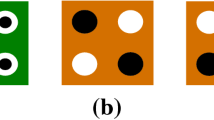Abstract
Approximate computing is an effective paradigm for energy-efficient hardware design in nanoscale. In this study, an efficient 4:2 compressor for approximate computing in the nano era is proposed. The proposed design includes only two majority gates instead of AND-OR and XOR logics, which leads to circuit efficiency and lower energy consumption. Moreover, the majority operator is the natural logic primitive for several beyond-CMOS technologies such as quantum-dot cellular automata (QCA). The proposed approach is designed using FinFET as a current industrial technology and QCA as a promising emerging nanodevice. FinFETs show lower short channel effects and provide excellent electrostatic characteristics than bulk CMOS for sub-32 nm technologies. Furthermore, QCA will provide extremely high-density and energy-efficient digital circuits for the future VLSI design. In order to evaluate the performance of the proposed approach and make comparisons with the previous designs, extensive simulations are performed using HSPICE, QCADesigner and QCAPro tools. In addition, the proposed compressor is utilized efficiently in image processing applications and the critical metrics in measuring the quality of images are evaluated using MATLAB. The results indicate significant improvements in terms of different performance and accuracy metrics in comparison with the most efficient designs previously presented in the literature.














Similar content being viewed by others
References
Abutaleb MM (2017) Robust and efficient quantum-dot cellular automata synchronous counters. Microelectron J 61:6–14
Akbari O, Kamal M, Afzali-Kusha A, Pedram M (2017) Dual-quality 4: 2 compressors for utilizing in dynamic accuracy configurable multipliers. IEEE Trans Very Large Scale Integr VLSI Syst 25(4):1352–1361
Amaru L, Gaillardon PE, Chattopadhyay A, De Micheli G (2016) A sound and complete axiomatization of majority-n logic. IEEE Trans Comput 65(9):2889–2895
Bagherian Khosroshahy M, Moaiyeri MH, Angizi S, Bagherzadeh N, Navi K (2017) Quantum-dot cellular automata circuits with reduced external fixed inputs. Microprocess Microsyst 50:154–163
Baran D, Aktan M, Oklobdzija VG (2010) Energy efficient implementation of parallel CMOS multipliers with improved compressors. In: ACM/IEEE international symposium on low-power electronics and design (ISLPED), pp 147–152
BSIM-CMG 110.0.0 (2015) Common multi-gate FET model
Chang H, Gu J, Zhang M (2004) Ultra low-voltage low-power CMOS 4-2 and 5-2 compressors for fast arithmetic circuits. IEEE Trans Circuits Syst I Regul Pap 51(10):1985–1997
Gupta SK, Roy K (2015) Low power robust FinFET-based SRAM design in scaled technologies. In: Circuit design for reliability. Springer, pp 223–253
Ibrahim W, Beiu V, Sulieman MH (2008) On the reliability of majority gates full adders. IEEE Trans Nanotechnol 7(1):56–67
Jha KN, Chen D (eds) (2010) Nanoelectronic circuit design. Springer Science & Business Media
Liang J, Han J, Lombardi F (2013) New metrics for the reliability of approximate and probabilistic adders. IEEE Trans Comput 62(9):1760–1771
Liu W, Swartzlander EE Jr, O’Neill M (2013) Design of semiconductor QCA systems. Artech House
Liu W, Lu L, O’Neill M, Swartzlander EE (2014) A first step toward cost functions for quantum-dot cellular automata designs. IEEE Trans Nanotechnol 13(3):476–487
Moghaddam M, Moaiyeri MH, Eshghi M (2017) Design and evaluation of an efficient Schmitt trigger-based hardened latch in CNTFET technology. IEEE Trans Device Mater Reliab 17(1):267–277
Momeni A, Han J, Montuschi P, Lombardi F (2015) Design and analysis of approximate compressors for multiplication. IEEE Trans Comput 64(4):984–994
Pishvaie A, Jaberipur G, Jahanian A (2014) High-performance CMOS (4:2) compressors. Int J Electron 101(11):1511–1525
Pudi V, Sridharan K, Lombardi F (2017) Majority logic formulations for parallel adder designs at reduced delay and circuit complexity. In: IEEE transactions on computers
Rabaey J (2009) Low power design essentials. Springer Science & Business Media
Rahimpour Gadim M, Jafari Navimipour N (2017) A new three-level fault tolerance arithmetic and logic unit based on quantum dot cellular automata. Microsyst Technol. doi:10.1007/s00542-017-3502-x
Rezaei Khezeli M, Moaiyeri MH, Jalali A (2017) Analysis of crosstalk effects for multiwalled carbon nanotube bundle interconnects in ternary logic and comparison with Cu interconnects. IEEE Trans Nanotechnol 16(1):107–117
Sen B, Chowdhury MR, Mukherjee R, Goswami M, Sikdar BK (2017) Reliability-aware design for programmable QCA logic with scalable clocking circuit. J Comput Electron 16(2):473–485
Sheikhfaal S, Angizi S, Sarmadi S, Moaiyeri MH, Sayedsalehi S (2015) Designing efficient QCA logical circuits with power dissipation analysis. Microelectron J 46:462–471
Srivastava S, Asthana A, Bhanja S, Sarkar S (2011) QCAPro-an error-power estimation tool for QCA circuit design. In: 2011 IEEE international symposium of circuits and systems (ISCAS), pp 2377–2380
Swahn B, Hassoun S (2006) Gate sizing: FinFETs vs 32 nm bulk MOSFETs. In: IEEE design automation conference, 43rd ACM/IEEE, pp 528–531
Taherkhani E, Moaiyeri MH, Angizi S (2017) Design of an ultra-efficient reversible full adder-subtractor in quantum-dot cellular automata. Opt Int J Light Electron Opt 142:557–563
Walus K, Vetteth A, Jullien G, Dimitrov V (2003) RAM design using quantum-dot cellular automata. In: Nanotechnology conference, pp 160–163
Walus K, Dysart TJ, Jullien GA, Budiman RA (2004) QCADesigner: a rapid design and simulation tool for quantum-dot cellular automata. IEEE Trans Nanotechnol 3(1):26–31
Wang Z, Bovik AC, Sheikh HR, Simoncelli EP (2004) Image quality assessment: from error visibility to structural similarity. IEEE Trans Image Process 13(4):600–612
Yang Y, Jeong H, Song SC, Wang J, Yeap G, Jung SO (2016) Single bit-line 7T SRAM cell for near-threshold voltage operation with enhanced performance and energy in 14 nm FinFET technology. IEEE Trans Circuits Syst I Regul Pap 63(7):1023–1032
Zimmermann R, Fichtner W (1997) Low-power logic styles: CMOS versus pass-transistor logic. IEEE J Solid State Circuits 32(7):1079–1090
Author information
Authors and Affiliations
Corresponding author
Rights and permissions
About this article
Cite this article
Moaiyeri, M.H., Sabetzadeh, F. & Angizi, S. An efficient majority-based compressor for approximate computing in the nano era. Microsyst Technol 24, 1589–1601 (2018). https://doi.org/10.1007/s00542-017-3587-2
Received:
Accepted:
Published:
Issue Date:
DOI: https://doi.org/10.1007/s00542-017-3587-2




